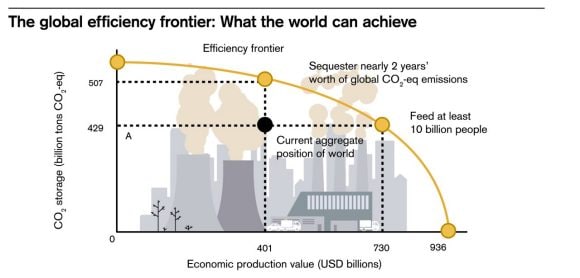The value of natural capital
The rising frequency and intensity of natural disasters raises the question: Is the value of natural capital sufficiently considered in economic planning today?

![]()
header.search.error
The rising frequency and intensity of natural disasters raises the question: Is the value of natural capital sufficiently considered in economic planning today?

Key takeaways:
On June 7 2023, the sky over New York turned into an apocalyptic orange as the most destructive wildfire season in Canada on record burned down vast areas of forests, sending thick bands of smoke over the US and even Europe.1,2 While several cities like Chicago, Detroit, and Minneapolis saw their air quality ratings jump to the worst levels worldwide, the wildfires also released a record 160 million tons of carbon emissions into the atmosphere.3 The rising frequency and intensity of natural disasters raises the question: Is the value of natural capital sufficiently considered in economic planning today?
Natural capital is managed inefficiently
Conventional economic models inadequately account for nature’s indispensable role in the economy – and even partly neglect the fact that the economy relies on nature. Agricultural, ecological, and economic models developed by the World Bank and the Natural Capital Project show that most countries utilize their natural capital inefficiently due to factors such as misallocated subsidies, insecure property rights, and inadequate protection of critical areas. The undervaluation of natural capital and the absence of proper pricing mechanisms further exacerbate the problem. Rectifying these inefficiencies and closing the gaps hold immense potential.4 Additionally, given ecosystems function as natural carbon sinks, countries could sequester 78 billion tons of carbon – almost two years of global emissions – if they were to close efficiency gaps (see figure 1, increasing CO2 storage from 429 to 507 billion tons of CO2-equivalents). This would provide crucial time for decarbonization efforts without sacrificing economic growth or food production.5 New framework developments like the United Nations System of Environmental-Economic Accounting (SEEA)6 are leading the way on how to recognize natural capital as an economic asset.

What is natural capital?
Natural capital refers to the stock of natural resources and ecosystems and can be broken down into three main categories:
The concept of natural capital recognizes the value of nature beyond its intrinsic worth and emphasizes the interdependence between the environment, society, and economic prosperity.
The economic value of nature
With approximately USD 44 trillion in economic value generation – more than half of the world’s gross domestic product (GDP) – in some way dependent on nature, the importance of nature for doing business is far higher than often assumed. More precisely, 15% of global GDP (USD 13 trillion) would be highly affected by a loss of natural service, while moderately dependent industries generate 37% (USD 31 trillion) of global GDP. The construction (USD 4 trillion), agriculture (USD 2.5 trillion), and food and beverage (USD 1.4 trillion) sectors top the list.7
GBP 44 trillion of economic value7
Over 50% of world GDP dependent on nature7
Economic value of highly nature-dependent industries8 equals 2x Germany’s economy
The rising price tag of natural disasters
Dealing with the rising number of natural disasters is becoming ever more costly. The records of insured losses caused by natural catastrophes show an upward trend for the last decades with an annual average growth of 5%–7%.9 The total economic loss from natural disasters worldwide stood at USD 275 billion in 2022, of which 45%, or USD 125 billion, was insured (see figure 2).10

The direct cost of dealing with natural disasters is rising in many areas, as seen e.g in the annual federal fire suppression spend in the US, which has been growing 8% per year since the 1980s.11 However, the real damage could conceivably be much greater since lost business, lost tax revenues, and prolonged depreciation of property values are not sufficiently accounted for.12 Greenhouse gases (GHG) released into the atmosphere are not included in current numbers either. The release of stored carbon from burning trees exacerbates the already elevated carbon dioxide (CO2) levels in the atmosphere. With estimates suggesting a significant increase in wildfires in Canadian and US forests, the carbon emissions from these events are threatening global carbon budgets. Using the example of the 160 million tons of carbon released by the Canadian wildfires in June 2023, this equates to USD 4.7 billion referencing the price of California carbon credits (USD 29.30 per ton) or USD 15.8 billion referencing the European Carbon price (EUR 88.24 – equivalent to USD 98.82 – per ton).13
The multiplier effect of climate change
This year’s list of severe heatwaves and droughts, record-breaking wildfires, devastating floods, and other natural catastrophes reads like a screenplay for a science-fiction disaster movie – and the year is far from over. Looking at the example of wildfires, climate change has created favorable conditions for such events as increased dryness, or aridification, has caused the atmosphere to become “thirstier” for water, draining moisture from trees and thus making them more vulnerable to fire.
A study conducted on California’s wildfires points to the link between climate change and the increased area burned and concludes that without human-caused greenhouse gas emissions, the burned area would have been significantly smaller. These findings reinforce the urgency of addressing climate change to mitigate the devastating impact of wildfires. In fact, new research suggests that approximately 40% of the forest area burned by wildfire in the western part of the United States and southwestern Canada in the last 40 years can be attributed to carbon emissions associated with the world’s 88 largest fossil fuel producers and cement manufacturers.14
Technologies for a nature-positive economy
While homeowners contemplate measures on how to reduce fire risk, by using e.g. fire-resistant materials on roofs,15 the key question is: Which products can help manage natural capital more efficiently?
Throughout history, technology has driven economic transformation, boosting productivity and growth. Technological advances expand frontiers, enabling greater production of economic and environmental services with the same resources.16 The use of technology can pave the way for a nature-positive economy in two main ways. First, it enables a significant improvement of data collection and interpretation, which is breaking into new areas with the help of artificial intelligence (AI). The immense growth of data availability enables new methods for assessing the economic and health effects of landscape changes. Initiatives like FireAId demonstrate how AI can significantly enhance wildfire prediction and prevention. Using more than 400 variables from 14 different datasets, AI-based models lead to an 80% accuracy rate in predicting wildfires 24 hours before their outbreak.17
Second, innovative technologies can transform the use of resources in the most relevant industries. Agriculture, retail sales and services, and the power sector contribute significantly to natural capital depletion. To mitigate this, adopting plant-based alternatives, advanced seed technology, and reducing food loss is crucial. According to McKinsey, following regenerative agriculture practices can generate value totaling USD 65 billion annually. In addition, switching to solar and wind power not only cuts the consumption of finite energy sources, but also saves water and reduces nutrient pollution, providing an estimated USD 95 billion in annual value. Addressing plastic waste through reduction, recycling, and alternative delivery models benefits the retail sector. All these strategies promote sustainability while considering economic factors.18
Concerted efforts needed to preserve natural capital
The game-changing impact of climate change on the state of natural resources and ecosystems requires a reconsideration of nature’s services that were historically taken for granted. In local and global economies, the service that nature provides is still largely undervalued today – if they are valued at all.
The wildfire case highlights the urgent need to address the root causes through concerted efforts to reduce greenhouse gas emissions, preserve ecosystems, and adopt sustainable practices. Technology will play an important role in this fundamental repositioning of the global economy. New technologies like AI can significantly enhance early detection, response, and resource allocation when fighting acute natural disasters and with that, contribute to preserving natural capital. Investors also play an important role in the preservation of natural capital. By allocating capital to companies that offer technologies supporting natural resource protection and that promote the disclosure of nature-related data, they help raise awareness of the need to consider natural capital in economic planning.

CAIA, Senior portfolio manager, Thematic Equities
Holger Frey is a Senior Portfolio Manager on the Thematic Equity team and lead Portfolio Manager for the Climate Solutions Equity strategy at UBS Asset Management. He joined the Thematic Equity team in 2021. From 2016 to 2021, he worked at RobecoSAM in Zurich as lead PM for the Circular Economy Equity and Sustainable Food Equity strategy. Holger started his career in 2004 as a financial consultant. In 2006, he moved to Deutsche Asset and Wealth Management, where in 2008 he began focusing on nutrition, water, and environmental technology sectors, becoming the lead PM for the water strategy. Holger has a Dipl.-Inf. (FH) degree in Computer Science and Media from Fulda University of Applied Sciences and a bachelor’s degree in Musicology from Goethe University Frankfurt. He is a CAIA Charterholder.